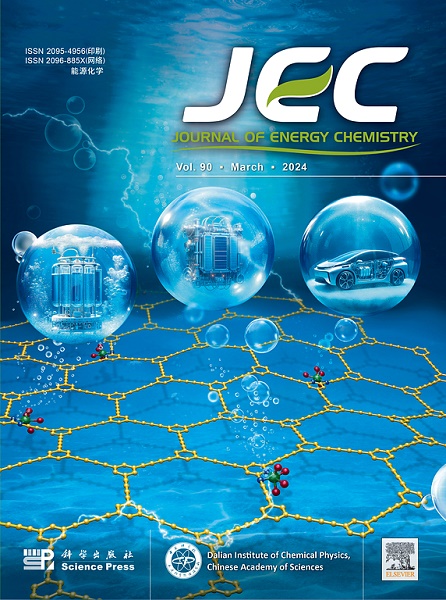通过优先配位终止界面氢键网络,实现稳定的锌金属阳极
IF 13.1
1区 化学
Q1 Energy
引用次数: 0
摘要
水性锌离子电池已成为下一代储能系统中有前途的候选者。然而,界面副反应,特别是锌金属阳极界面的析氢反应(HER)严重阻碍了它们的实际实施。在此,本研究提出了一种创新的方法,通过在锌阳极表面构建界面优先配位层来解决这一挑战。该层有效地终止了界面氢键网络的连续性,阻断了质子的传输,从而减轻了HER。具体而言,引入亲锌基团的2-苯基苯并咪唑-5-磺酸(PBSA)作为电解质添加剂,通过其亲锌的氮和磺酸优先、选择性地锚定在Zn表面,形成界面配位层。该配位层起到保护屏障的作用,将水分子从锌电极表面排斥,减轻水的分解。最关键的是,界面配位层与界面水分子之间的氢键相互作用更强,终止了水分子之间的氢键网络,阻碍了质子的运输和电还原,最终抑制了界面处的HER。结果表明,添加PBSA/ZnSO4的Zn对称电池在1 mA cm−2下具有较高的2500 h循环稳定性,添加PBSA/ZnSO4的Zn//NH4V4O10全电池具有更强的容量保持能力。该界面氢键调节策略为高性能水性电池无her界面保护层的设计提供了有价值的见解。本文章由计算机程序翻译,如有差异,请以英文原文为准。

Terminating interfacial hydrogen-bond networks via preferential coordination for stable zinc metal anode
Aqueous zinc-ion batteries have emerged as promising candidates in next-generation energy storage systems. However, their practical implementation is significantly hindered by interfacial side reactions, particularly the hydrogen evolution reaction (HER) at the Zn metal anode interface. Herein, this study presents an innovative approach to address this challenge through the construction of an interfacial preferential coordination layer on the Zn anode surface. The proposed layer effectively terminates the continuity of interfacial hydrogen-bond networks and blocks proton transport, thereby mitigating the HER. Specifically, 2-phenylbenzimidazole-5-sulfonic acid (PBSA) with zincophilic groups was introduced as an electrolyte additive, which would be preferentially and selectively anchored on the Zn surface through its zincophilic nitrogen and sulfonic acid, forming the interfacial coordination layer. This coordination layer serves as a protective barrier, repelling water molecules from the Zn electrode surface and alleviating water decomposition. Crucially, the interfacial coordination layer features stronger hydrogen-bonding interactions with interfacial water molecules, terminates the hydrogen-bonding network between water molecules, hinders the transportation and electro-reduction of proton, and ultimately inhibits HER at the interface. As a result, the Zn symmetric cell with PBSA/ZnSO4 delivered higher cycling stability of 2500 h at 1 mA cm−2 and Zn//NH4V4O10 full cells with PBSA/ZnSO4 possessed enhanced capacity retention. This interfacial hydrogen-bond regulation strategy provided valuable insight for designing HER-free interfacial protective layer in high-performance aqueous batteries.
求助全文
通过发布文献求助,成功后即可免费获取论文全文。
去求助
来源期刊

Journal of Energy Chemistry
CHEMISTRY, APPLIED-CHEMISTRY, PHYSICAL
CiteScore
19.10
自引率
8.40%
发文量
3631
审稿时长
15 days
期刊介绍:
The Journal of Energy Chemistry, the official publication of Science Press and the Dalian Institute of Chemical Physics, Chinese Academy of Sciences, serves as a platform for reporting creative research and innovative applications in energy chemistry. It mainly reports on creative researches and innovative applications of chemical conversions of fossil energy, carbon dioxide, electrochemical energy and hydrogen energy, as well as the conversions of biomass and solar energy related with chemical issues to promote academic exchanges in the field of energy chemistry and to accelerate the exploration, research and development of energy science and technologies.
This journal focuses on original research papers covering various topics within energy chemistry worldwide, including:
Optimized utilization of fossil energy
Hydrogen energy
Conversion and storage of electrochemical energy
Capture, storage, and chemical conversion of carbon dioxide
Materials and nanotechnologies for energy conversion and storage
Chemistry in biomass conversion
Chemistry in the utilization of solar energy
 求助内容:
求助内容: 应助结果提醒方式:
应助结果提醒方式:


